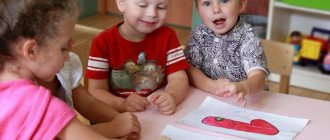Speech development in preschool age
Communication is an activity that a child masters at an early age. Without communication, it would be impossible to exist in society, receive and transmit information, successfully socialize and interact with others.
For your information! Well-delivered speech of a preschooler has a positive effect not only on interaction with others, but also on the child’s self-esteem, its internal characteristics: the adequacy of ideas about oneself and one’s capabilities, self-confidence, and emotional comfort.
Speech development of preschool children is one of the structural units of the personality development program according to the Federal State Educational Standard. The compiled program assumes:
- mastery of speech as a means of communication and culture;
- expanding the child’s vocabulary;
- formation of correct dialogic and monologue speech;
- familiarity with fiction and various genres;
- timely correction of speech disorders.
Socializing with peers is a key activity
Linguistic means of visualization and expressiveness in fairy tales
To make fairy tales interesting to children and have a lively narrative language, the authors use various means of expression. Over the centuries, a large number of them have been developed. A fairy tale is created thanks to the unity of all poetic means: epithets, metaphors, comparisons, personifications, etc. The main characters acquire the traits necessary for the author thanks to epithets: the fox becomes cunning, the piglets become sloppy.
For your information! With the help of personification, the author endows inanimate objects with human characteristics so that children's imagination can identify with the main character and empathize with him.
Features of Russian folk tales
Russian folk tales are written in bright, expressive language. They not only expand their vocabulary, but also help the child construct dialogues correctly and develop coherent speech. There are many figurative expressions and phraseological units in folklore. Folk tales are a kind of guide for mastering the norms of the Russian language.
Russian folk tales are divided into three groups:
- about animals, where animals behave like people, for example, “Cockerel is a golden comb”;
- everyday ones, the heroes of which are ordinary people - peasants, villagers, soldiers, for example, “Nikita Kozhemyaka”;
- magical ones, which represent an evil force and victory over it, for example, “Sivka-burka”.
Classic characters from Russian folk tales







